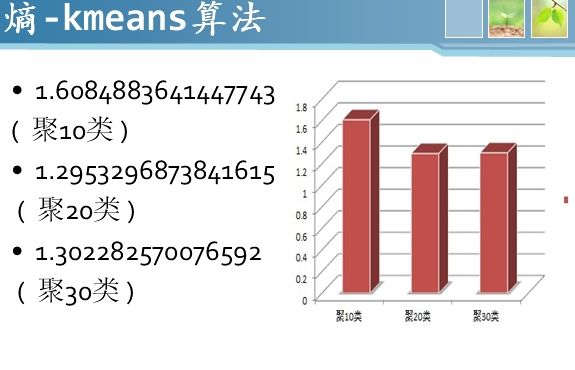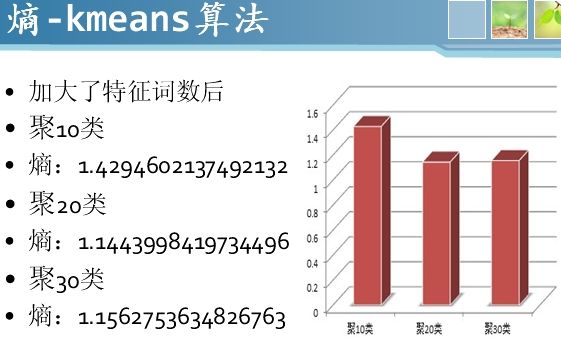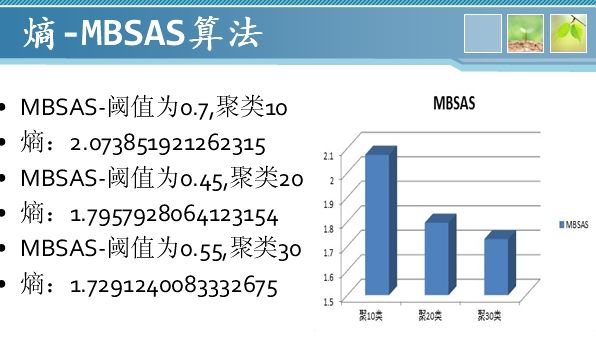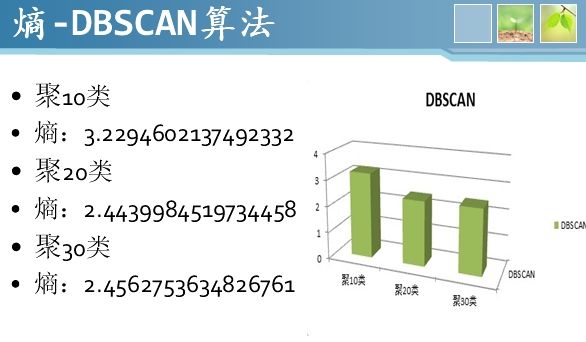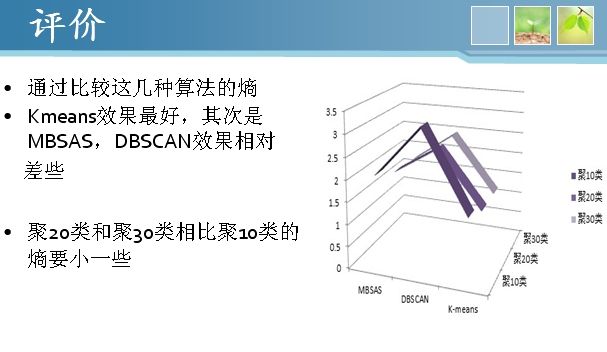数据挖掘-基于Kmeans算法、MBSAS算法及DBSCAN算法的newsgroup18828文本聚类器的JAVA实现(下)
本文接数据挖掘-基于Kmeans算法、MBSAS算法及DBSCAN算法的newsgroup18828文本聚类器的JAVA实现(上).
(update 2012.12.28 关于本项目下载及运行的常见问题 FAQ见 newsgroup18828文本分类器、文本聚类器、关联分析频繁模式挖掘算法的Java实现工程下载及运行FAQ )
本文要点如下:
介绍基于LSI(隐性语义索引)中SVD分解做特征降维的方法
介绍两外两种文本聚类算法MBSAS算法及DBSCAN算法
对比三种算法对newsgroup18828文档集的聚类效果
1、SVD分解降维
以词项(terms)为行, 文档(documents)为列做一个大矩阵(matrix). 设一共有t行d列, 矩阵名为A. 矩阵的元素为词项的tf-idf值。然后对该矩阵做SVD分解 A=T*S*D‘,把S的m个对角元素的前k个保留(最大的k个保留), 后m-k个置0, 我们可以得到一个新的近似的分解: Xhat=T*S*D’ 。Xhat在最小二乘意义下是X的最佳近似
给定矩阵A, 基于A可以问三类同文件检索密切有关的问题
术语i和j有多相似?
即术语的类比和聚类问题
文件i和j有多相似?
即文件的类比和聚类问题
术语i和文件j有多相关?
即术语和文件的关联问题
利用SVD分解得到的矩阵可以计算这三个问题,方法如下(DT代表D的转置,以此类推)
比较两个术语
做"正向"乘法:
Xhat*XhatT=T*S*DT*D*S*TT=T*S2*TT=(TS)*(TS)T
DT*D=I, 因为D已经是正交归一的 ,s=sT
它的第i行第j列表明了术语i和j的相似程度
比较两个文件做"逆向"乘法:
XhatT*Xhat=D*S*TT*T*S*DT=D*S2*DT=(DS)(DS)T
TT*T=I, 因为T已经是正交归一的, s=sT
它的第i行第j列表明了文件i和j的相似程度
此法给出了求文件之间相似度的一个途径,于是可以基于此相似度矩阵实现K-means算法
比较一个文件和一个术语恰巧就是Xhat本身.
它的第i行第j列表明了术语i和文件j的相关联程度.
SVD分解主要基于JAMA矩阵运算包实现,JAMA矩阵运算包下载见http://math.nist.gov/javanumerics/jama/
DimensionReduction.java
- package com.pku.yangliu;
- import java.io.IOException;
- import java.util.Iterator;
- import java.util.Map;
- import java.util.Set;
- import Jama.Matrix;
- import Jama.SingularValueDecomposition;
- /**基于LSI对文档的特征向量做降维,SVD运算基于JAMA矩阵运算包实现
- *
- */
- public class DimensionReduction {
- /**把测试样例的map转化成文档相似性矩阵
- * @param Map<String, Map<String, Double>> allTestSampleMap 所有测试样例的<文件名,向量>构成的map
- * @param String[] terms 特征词集合
- * @return double[][] doc-doc相似性矩阵
- * @throws IOException
- */
- public double[][] getSimilarityMatrix(
- Map<String, Map<String, Double>> allTestSampleMap, String[] terms) {
- // TODO Auto-generated method stub
- System.out.println("Begin compute docTermMatrix!");
- int i = 0;
- double [][] docTermMatrix = new double[allTestSampleMap.size()][terms.length];
- Set<Map.Entry<String, Map<String,Double>>> allTestSampleMapSet = allTestSampleMap.entrySet();
- for(Iterator<Map.Entry<String, Map<String,Double>>> it = allTestSampleMapSet.iterator();it.hasNext();){
- Map.Entry<String, Map<String,Double>> me = it.next();
- for(int j = 0; j < terms.length; j++){
- if(me.getValue().containsKey(terms[j])){
- docTermMatrix[i][j] = me.getValue().get(terms[j]);
- }
- else {
- docTermMatrix[i][j] =0;
- }
- }
- i++;
- }
- double[][] similarityMatrix = couputeSimilarityMatrix(docTermMatrix);
- return similarityMatrix;
- }
- /**基于docTermMatrix生成相似性矩阵
- * @param double[][] docTermMatrix doc-term矩阵
- * @return double[][] doc-doc相似性矩阵
- * @throws IOException
- */
- private double[][] couputeSimilarityMatrix(double[][] docTermMatrix) {
- // TODO Auto-generated method stub
- System.out.println("Compute docTermMatrix done! begin compute SVD");
- Matrix docTermM = new Matrix(docTermMatrix);
- SingularValueDecomposition s = docTermM.transpose().svd();
- System.out.println(" Compute SVD done!");
- //A*A' = D*S*S'*D' 如果是doc-term矩阵
- //A'*A = D*S'*S*D' 如果是term-doc矩阵
- //注意svd函数只适合行数大于列数的矩阵,如果行数小于列数,可对其转置矩阵做SVD分解
- Matrix D = s.getU();
- Matrix S = s.getS();
- for(int i = 100; i < S.getRowDimension(); i++){//降到100维
- S.set(i, i, 0);
- }
- System.out.println("Compute SimilarityMatrix done!");
- return D.times(S.transpose().times(S.times(D.transpose()))).getArray();
- }
- }
有了上面得到的文档与文档之间的相似性矩阵后,我们就可以实现另一个版本的K-means算法了。注意中心点的计算是直接对该聚类中的所有文档的距离向量求平均,作为该中心点与其他所有文档的距离。具体实现如下,主函数在数据挖掘-基于Kmeans算法、MBSAS算法及DBSCAN算法的newsgroup18828文本聚类器的JAVA实现(上)中已经给出。
- package com.pku.yangliu;
- import java.io.FileWriter;
- import java.io.IOException;
- import java.util.Iterator;
- import java.util.Map;
- import java.util.Set;
- import java.util.TreeMap;
- import java.util.Vector;
- import java.lang.Integer;
- /**Kmeans聚类算法的实现类,将newsgroups文档集聚成10类、20类、30类,采用SVD分解
- * 算法结束条件:当每个点最近的聚类中心点就是它所属的聚类中心点时,算法结束
- *
- */
- public class KmeansSVDCluster {
- /**Kmeans算法主过程
- * @param Map<String, Map<String, Double>> allTestSampleMap 所有测试样例的<文件名,向量>构成的map
- * @param double [][] docSimilarityMatrix 文档与文档的相似性矩阵 [i,j]为文档i与文档j的相似性度量
- * @param int K 聚类的数量
- * @return Map<String,Integer> 聚类的结果 即<文件名,聚类完成后所属的类别标号>
- * @throws IOException
- */
- private Map<String, Integer> doProcess(
- Map<String, Map<String, Double>> allTestSampleMap, double[][] docSimilarityMatrix, int K) {
- // TODO Auto-generated method stub
- //0、首先获取allTestSampleMap所有文件名顺序组成的数组
- String[] testSampleNames = new String[allTestSampleMap.size()];
- int count = 0, tsLength = allTestSampleMap.size();
- Set<Map.Entry<String, Map<String, Double>>> allTestSampeleMapSet = allTestSampleMap.entrySet();
- for(Iterator<Map.Entry<String, Map<String, Double>>> it = allTestSampeleMapSet.iterator(); it.hasNext(); ){
- Map.Entry<String, Map<String, Double>> me = it.next();
- testSampleNames[count++] = me.getKey();
- }
- //1、初始点的选择算法是随机选择或者是均匀分开选择,这里采用后者
- Map<Integer, double[]> meansMap = getInitPoint(testSampleNames, docSimilarityMatrix, K);//保存K个中心点
- //2、初始化K个聚类
- int [] assignMeans = new int[tsLength];//记录所有点属于的聚类序号,初始化全部为0
- Map<Integer, Vector<Integer>> clusterMember = new TreeMap<Integer,Vector<Integer>>();//记录每个聚类的成员点序号
- Vector<Integer> mem = new Vector<Integer>();
- int iterNum = 0;//迭代次数
- while(true){
- System.out.println("Iteration No." + (iterNum++) + "----------------------");
- //3、找出每个点最近的聚类中心
- int[] nearestMeans = new int[tsLength];
- for(int i = 0; i < tsLength; i++){
- nearestMeans[i] = findNearestMeans(meansMap, i);
- }
- //4、判断当前所有点属于的聚类序号是否已经全部是其离得最近的聚类,如果是或者达到最大的迭代次数,那么结束算法
- int okCount = 0;
- for(int i = 0; i <tsLength; i++){
- if(nearestMeans[i] == assignMeans[i]) okCount++;
- }
- System.out.println("okCount = " + okCount);
- if(okCount == tsLength || iterNum >= 25) break;//最大迭代次数1000次
- //5、如果前面条件不满足,那么需要重新聚类再进行一次迭代,需要修改每个聚类的成员和每个点属于的聚类信息
- clusterMember.clear();
- for(int i = 0; i < tsLength; i++){
- assignMeans[i] = nearestMeans[i];
- if(clusterMember.containsKey(nearestMeans[i])){
- clusterMember.get(nearestMeans[i]).add(i);
- }
- else {
- mem.clear();
- mem.add(i);
- Vector<Integer> tempMem = new Vector<Integer>();
- tempMem.addAll(mem);
- clusterMember.put(nearestMeans[i], tempMem);
- }
- }
- //6、重新计算每个聚类的中心点
- for(int i = 0; i < K; i++){
- if(!clusterMember.containsKey(i)){//注意kmeans可能产生空聚类
- continue;
- }
- double[] newMean = computeNewMean(clusterMember.get(i), docSimilarityMatrix);
- meansMap.put(i, newMean);
- }
- }
- //7、形成聚类结果并且返回
- Map<String, Integer> resMap = new TreeMap<String, Integer>();
- for(int i = 0; i < tsLength; i++){
- resMap.put(testSampleNames[i], assignMeans[i]);
- }
- return resMap;
- }
- /**计算新的聚类中心与每个文档的相似度
- * @param clusterM 该聚类包含的所有文档的序号
- * @param double [][] docSimilarityMatrix 文档之间的相似度矩阵
- * @return double[] 新的聚类中心与每个文档的相似度
- * @throws IOException
- */
- private double[] computeNewMean(Vector<Integer> clusterM,
- double [][] docSimilarityMatrix) {
- // TODO Auto-generated method stub
- double sim;
- double [] newMean = new double[docSimilarityMatrix.length];
- double memberNum = (double)clusterM.size();
- for(int i = 0; i < docSimilarityMatrix.length; i++){
- sim = 0;
- for(Iterator<Integer> it = clusterM.iterator(); it.hasNext();){
- sim += docSimilarityMatrix[it.next()][i];
- }
- newMean[i] = sim / memberNum;
- }
- return newMean;
- }
- /**找出距离当前点最近的聚类中心
- * @param Map<Integer, double[]> meansMap 中心点Map value为中心点和每个文档的相似度
- * @param int m
- * @return i 最近的聚类中心的序 号
- * @throws IOException
- */
- private int findNearestMeans(Map<Integer, double[]> meansMap ,int m) {
- // TODO Auto-generated method stub
- double maxSim = 0;
- int j = -1;
- double[] simArray;
- Set<Map.Entry<Integer, double[]>> meansMapSet = meansMap.entrySet();
- for(Iterator<Map.Entry<Integer, double[]>> it = meansMapSet.iterator(); it.hasNext();){
- Map.Entry<Integer, double[]> me = it.next();
- simArray = me.getValue();
- if(maxSim < simArray[m]){
- maxSim = simArray[m];
- j = me.getKey();
- }
- }
- return j;
- }
- /**获取kmeans算法迭代的初始点
- * @param k 聚类的数量
- * @param String[] testSampleNames 测试样例文件名数组
- * @param double[][] docSimilarityMatrix 文档相似性矩阵
- * @return Map<Integer, double[]> 初始中心点容器 key是类标号,value为该类与其他文档的相似度数组
- * @throws IOException
- */
- private Map<Integer, double[]> getInitPoint(String[] testSampleNames, double[][] docSimilarityMatrix, int K) {
- // TODO Auto-generated method stub
- int i = 0;
- Map<Integer, double[]> meansMap = new TreeMap<Integer, double[]>();//保存K个聚类中心点向量
- System.out.println("本次聚类的初始点对应的文件为:");
- for(int count = 0; count < testSampleNames.length; count++){
- if(count == i * testSampleNames.length / K){
- meansMap.put(i, docSimilarityMatrix[count]);
- System.out.println(testSampleNames[count]);
- i++;
- }
- }
- return meansMap;
- }
- /**输出聚类结果到文件中
- * @param kmeansClusterResultFile 输出文件目录
- * @param kmeansClusterResult 聚类结果
- * @throws IOException
- */
- private void printClusterResult(Map<String, Integer> kmeansClusterResult, String kmeansClusterResultFile) throws IOException {
- // TODO Auto-generated method stub
- FileWriter resWriter = new FileWriter(kmeansClusterResultFile);
- Set<Map.Entry<String,Integer>> kmeansClusterResultSet = kmeansClusterResult.entrySet();
- for(Iterator<Map.Entry<String,Integer>> it = kmeansClusterResultSet.iterator(); it.hasNext(); ){
- Map.Entry<String, Integer> me = it.next();
- resWriter.append(me.getKey() + " " + me.getValue() + "\n");
- }
- resWriter.flush();
- resWriter.close();
- }
- /**Kmeans算法
- * @param String testSampleDir 测试样例目录
- * @param String[] term 特征词数组
- * @throws IOException
- */
- public void KmeansClusterMain(String testSampleDir, String[] terms) throws IOException {
- //首先计算文档TF-IDF向量,保存为Map<String,Map<String,Double>> 即为Map<文件名,Map<特征词,TF-IDF值>>
- ComputeWordsVector computeV = new ComputeWordsVector();
- DimensionReduction dimReduce = new DimensionReduction();
- int[] K = {10, 20, 30};
- Map<String,Map<String,Double>> allTestSampleMap = computeV.computeTFMultiIDF(testSampleDir);
- //基于allTestSampleMap生成一个doc*term矩阵,然后做SVD分解
- double[][] docSimilarityMatrix = dimReduce.getSimilarityMatrix(allTestSampleMap, terms);
- for(int i = 0; i < K.length; i++){
- System.out.println("开始聚类,聚成" + K[i] + "类");
- String KmeansClusterResultFile = "F:/DataMiningSample/KmeansClusterResult/";
- Map<String,Integer> KmeansClusterResult = new TreeMap<String, Integer>();
- KmeansClusterResult = doProcess(allTestSampleMap, docSimilarityMatrix, K[i]);
- KmeansClusterResultFile += K[i];
- printClusterResult(KmeansClusterResult,KmeansClusterResultFile);
- System.out.println("The Entropy for this Cluster is " + computeV.evaluateClusterRes(KmeansClusterResultFile, K[i]));
- }
- }
- }
另外两种聚类算法MBSAS算法和DBSCAN算法由我们组另外两位同学实现,其实也很简单,源码这里就不贴出来了。感兴趣的朋友可以到点击打开链接下载eclipse工程运行。这三种算法的聚类结果采用熵值大小来评价,熵值越小聚类效果越好,具体如下
可见对newsgroup文档集聚类采用K-means算法,用余弦相似度或者内积度量相似度可以达到良好的效果。而SVD分解还是很耗时间,事实上对20000X3000的矩阵做SVD分解的时间慢得难以忍受,我还尝试对小规模数据聚类,但是发现降维后聚类结果熵值超过了2,不及DF法降维的聚类效果。因此对于文本聚类的SVD降维未必是好方法,。除了这三种聚类算法,还有层次聚类算法等其他很多算法,以后会尝试给出其他算法的实现和聚类效果对比。敬请关注:)
